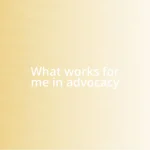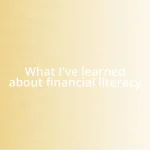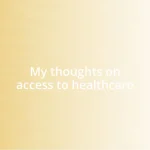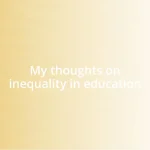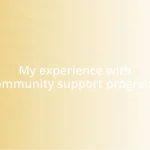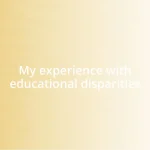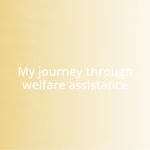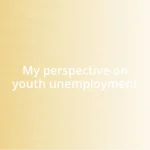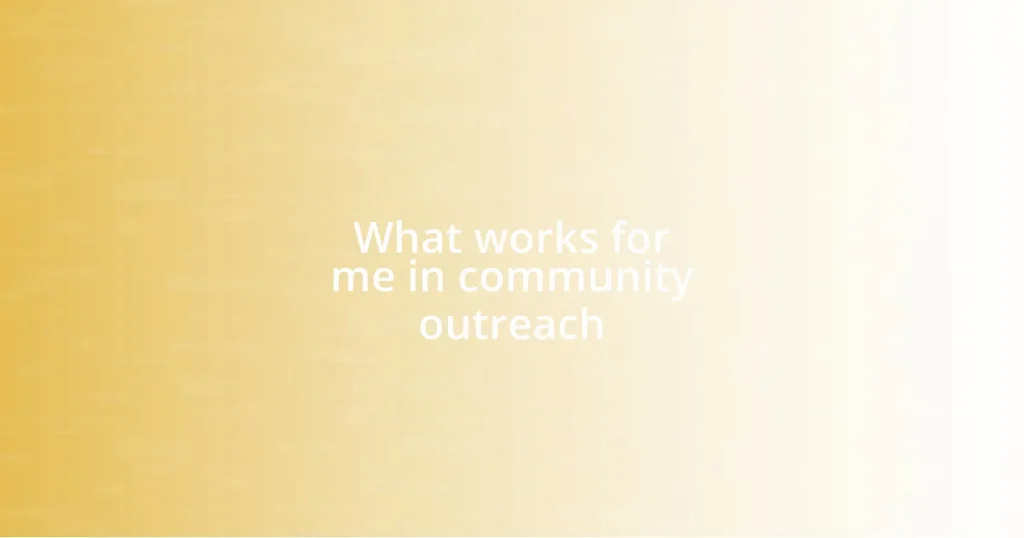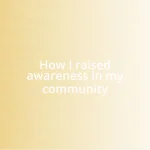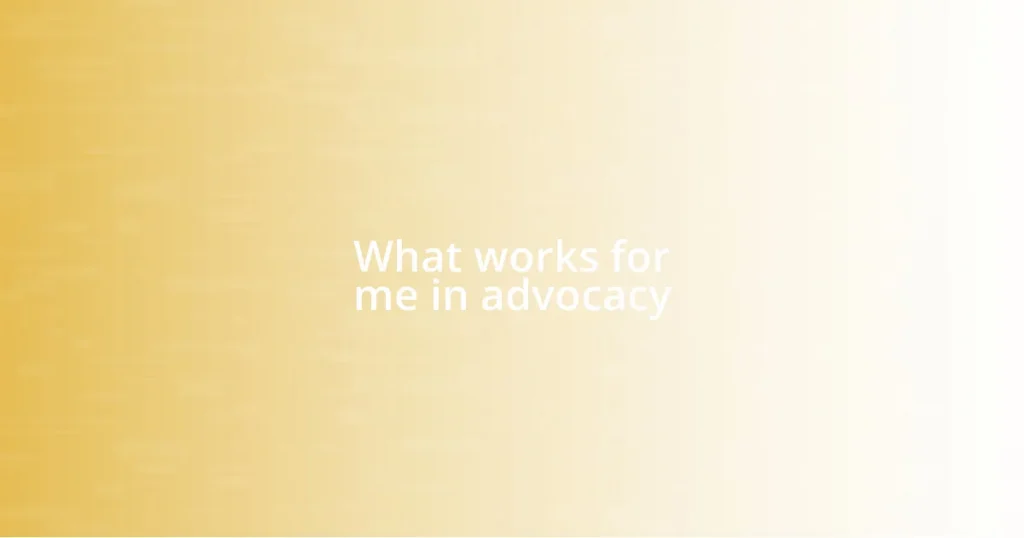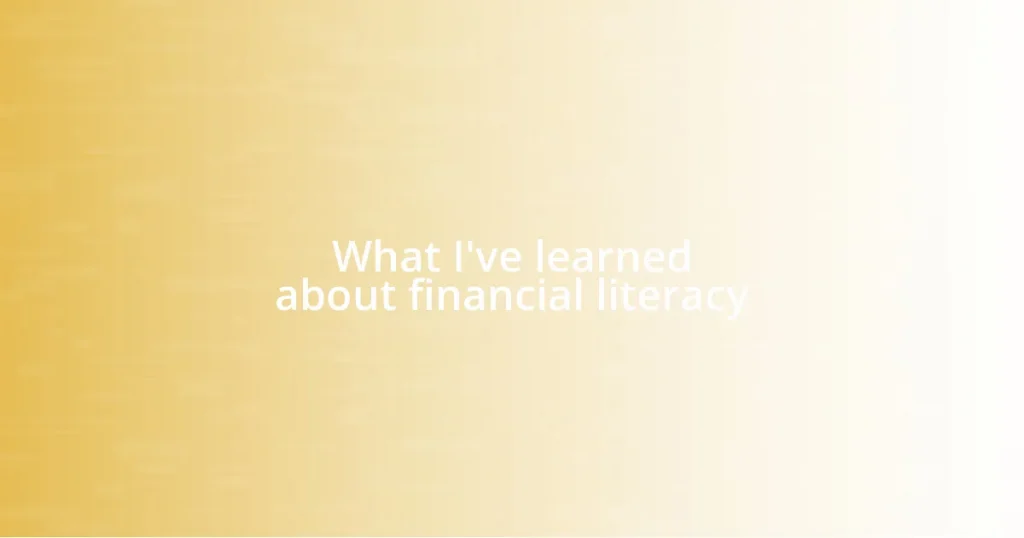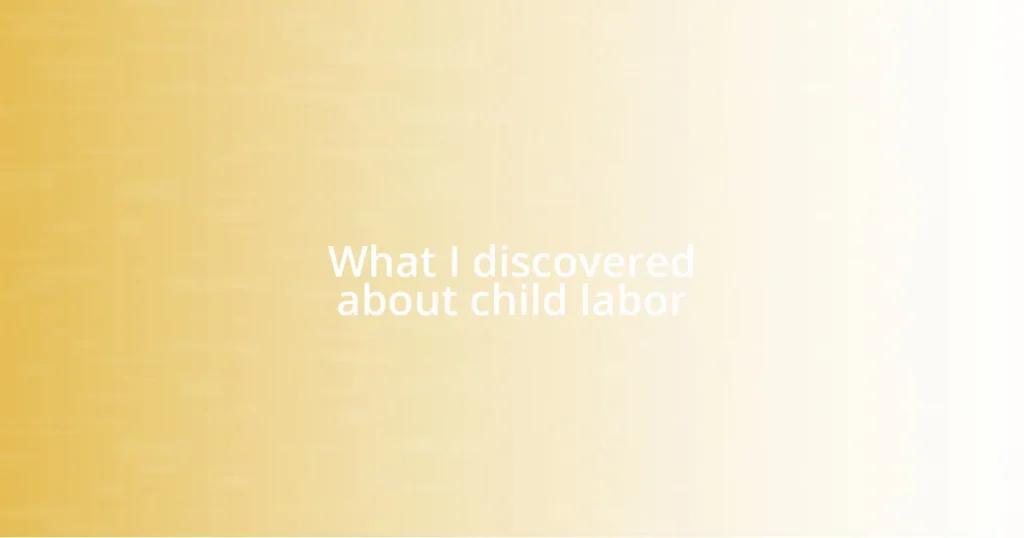Key takeaways:
- Clearly defined outreach goals and adaptability are crucial for impactful community engagement.
- Utilizing demographic data, community engagement, and social media helps in effectively identifying target communities.
- Building partnerships with local organizations fosters mutual benefits and strengthens community ties.
- Measuring outreach success involves qualitative feedback and tracking engagement, not just participant numbers.

Understanding community outreach goals
When I think about community outreach goals, I often reflect on my early experiences. One particular event stands out—organizing a local cleanup day. My goal was simple: to bring people together and foster pride in our neighborhood. But I learned that clearly defined objectives, like increasing participation or building lasting relationships, can transform a simple gathering into a powerful movement.
Understanding what you want to achieve is crucial. Are you aiming to educate, support, or empower your community? I’ve encountered moments of doubt wondering if my efforts were making a real impact. But then, hearing a participant share how our workshops inspired them to start their own project reminded me why setting specific goals is vital; they give your work direction and meaning.
One of the most enlightening lessons I’ve learned is the importance of adaptability. During one outreach initiative, our original goal shifted as community needs evolved. It was an emotional moment when we decided to listen and respond to our audience. How often do we cling to a plan without considering the changing dynamics? By embracing flexibility, I discovered that our goals could grow alongside our community, enhancing our connection and effectiveness.

Identifying target communities effectively
Identifying the right communities for outreach can feel overwhelming, but it’s incredibly rewarding once you find your focus. In my experience, utilizing demographic data can help pinpoint groups that not only need support but also have the potential to engage with your initiatives. For instance, I once analyzed local census data and discovered a vibrant neighborhood that was underutilized in our programs. It turned out they were eager for resources, leading to a successful partnership that sparked real change.
Another effective strategy is actively engaging with community leaders and local organizations. I recall volunteering at a community fair where I struck up a conversation with a local leader who provided insights into areas that genuinely needed attention. These conversations not only opened doors to potential collaborations but also helped me understand the unique challenges each community faces. Listening and learning from those within the community can lead to more meaningful outreach efforts.
Lastly, leveraging social media can be a game-changer for identifying target communities. I often take time to explore local groups online, witnessing firsthand the issues and interests that resonate with residents. By participating in discussions, I’ve been able to gauge the pulse of different communities, allowing me to tailor my outreach strategies effectively. This combination of research, relationships, and real-time engagement has been crucial in developing my outreach work.
| Strategy | Description |
|---|---|
| Demographic Analysis | Utilize local census data to identify communities needing support. |
| Community Engagement | Connect with local leaders and organizations for insights on community challenges. |
| Social Media Exploration | Engage with community discussions online to understand interests and needs. |

Building partnerships with local organizations
Building partnerships with local organizations can be one of the most impactful decisions in community outreach, and I’ve experienced this firsthand. In one of my endeavors, I reached out to a local food bank to collaborate on a nutrition education program. Their established presence in the community and deep understanding of the local dynamics provided invaluable insights. Together, we designed workshops that were not only well-attended but also created a supportive environment where individuals felt empowered to share their own experiences around food and health. It was a beautiful reminder that everyone has something to contribute when we stand together.
Here are crucial points that have worked well for me:
- Shared Goals: Align your objectives with those of local organizations to create a mutually beneficial partnership.
- Open Communication: Maintain ongoing dialogue to ensure all parties are on the same page, making adjustments as needed.
- Celebrate Success Together: Highlight successes, no matter how small, to foster continued collaboration and community engagement.
When I reflect on these interactions, I see how building genuine connections with local organizations enriches not only the projects we undertake but also the relationships we create within the community.

Creating engaging outreach programs
Creating outreach programs that truly engage the community requires a thoughtful blend of creativity and relevance. I once facilitated a community clean-up day, integrating environmentally focused activities that appealed to different age groups. Watching families gather to paint murals on local walls while children played nearby created a sense of ownership and excitement that made the day memorable. It’s rewarding to see how such initiatives energize community spirit and foster connections in unexpected ways.
Another technique I’ve found effective is incorporating local culture into outreach efforts. When I organized a health fair, I collaborated with local artists to showcase their work, intertwining health information with cultural expression. This approach not only attracted a diverse group of attendees but also made the event feel welcoming and relatable. Aren’t we more likely to engage when we see our own stories reflected in the programs?
Lastly, I believe that feedback loops are essential for continuously improving outreach programs. After each event, I send out surveys, and I also take the time to hold informal conversations with participants. These discussions reveal what resonated with them and what didn’t, helping me refine future initiatives. It’s almost like a continuous conversation; who wouldn’t appreciate having their voice heard in shaping the community? The beauty is in adapting and growing together, fostering an evolving environment of trust and collaboration.

Utilizing social media for outreach
Social media has transformed the landscape of community outreach in ways I’ve found truly remarkable. I remember when I created a Facebook event for a local health workshop, and within hours, people I had never met reached out with questions and support. It’s fascinating how a single post can ignite conversations and foster connections, making individuals feel more invested in the community.
Engaging with the audience on platforms such as Instagram and Twitter has also been game-changing. By sharing stories and photos from our events, I’ve witnessed the ripple effect of engagement. People comment, share, and often express their enthusiasm, creating a sense of belonging that extends beyond the screen. Have you ever noticed how this virtual engagement often translates into physical participation? Those interactions encourage more individuals to join our programs when they see their friends being involved.
Moreover, I often use social media to gather feedback and suggestions. I recently ran a poll on our outreach initiatives, and the responses were eye-opening. Not only did it reaffirm that people crave a voice in community activities, but it also afforded me new insights into what our community truly values. Isn’t it amazing how a simple online presence can lead to deeper understanding and collaboration? Each like, share, and comment strengthens our community bonds and opens up new avenues for outreach efforts.

Measuring outreach success
Measuring the success of outreach efforts goes beyond just counting attendees or participants. I remember one event where we had a modest turnout, yet the conversations sparked were invaluable. A woman approached me afterward, sharing how inspired she felt to start a neighborhood support group, which was far more impactful than the number of people we could physically count. Isn’t it fascinating how a single meaningful connection can sometimes outweigh sheer numbers?
To effectively measure outreach success, I also rely on qualitative feedback. At one initiative, we introduced a storytelling segment, encouraging participants to share their experiences. The stories that emerged not only illuminated the event’s effectiveness but also fostered a collective sense of pride in our community’s narratives. Did you know that listening to personal stories can create a deeper emotional resonance? I often find that these insights guide future outreach strategies by highlighting what matters most to the community.
Additionally, I track engagement metrics, like social media interactions, to gauge interest and connection. I launched a campaign where we challenged community members to share their experiences online, and the response was overwhelming. And you know what? Their posts not only amplified our outreach but also created a buzz that translated into higher turnout for our next event. It truly demonstrates the power of shared enthusiasm—doesn’t it make you wonder about uncovering the hidden impact of outreach initiatives?

Adapting strategies based on feedback
Adapting strategies based on feedback has been pivotal in my community outreach journey. I recall a time when I received constructive criticism after hosting a workshop. A participant suggested that the session was too technical for newcomers. This insight was invaluable and prompted me to simplify my approach, which not only made future workshops more accessible but also attracted a wider audience. Have you ever had your perspective change dramatically because of someone’s feedback?
By actively seeking feedback through surveys and informal conversations, I’ve learned that the community’s voice shapes our initiatives significantly. One memorable instance was when I asked attendees to share their thoughts on our monthly meetings. The overwhelming response highlighted a desire for more interactive formats. It was a clear signal for me to innovate, leading to the introduction of breakout sessions. This shift made our gatherings more dynamic and, ultimately, more fulfilling for everyone involved—don’t you think that adapting to audience preferences can create a richer experience?
Moreover, I’ve found that follow-up discussions after events can lead to transformative insights. After a community cleanup, I organized a casual picnic where participants could share their thoughts on what worked and what didn’t. One person mentioned the need for better coordination, which sparked an idea to create a volunteer app for easier scheduling. Seeing how feedback can spark practical changes always amazes me. It reinforces the idea that listening isn’t just about hearing words; it’s about transforming those insights into actionable strategies for a better community experience. How do you incorporate the feedback you receive?
